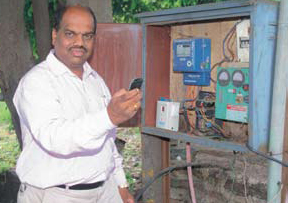NOTE: This Innovation Is Involved In A Dispute
We are awaiting an update the involved parties through a court to understand who the real innovator is. Once we receive an update, we will update this page.
MARCH 2010: Reaching your doctor, booking movie tickets or paying credit card bills, everything is just a simple matter with your mobile phone. A new feather in this cap is the mobile being used as a remote control to control pumps in rural areas. Nano Ganesh, a mobile phone based application developed by Ossian Agro Automation (a company working on rural automation since 14 years), allows farmers to switch on/control their pumpsets by pressing a few keys on their mobile.
“The farmer can monitor and check availability of the power at the pump, switch the pump on/off and acknowledge on/off status of the water pump from any place. One of its kinds, Nano Ganesh is specially designed to be robust to perform efficiently in the rural atmosphere where problems like voltage fluctuations, shock hazards, open wiring and marshy terrain are common,” says Santosh Ostwal, CEO, Ossian Agro Automation.
Nano Ganesh is made of four stages: regulated 5V and 12V DC power supply, DTMF decoder circuit and optical isolators, tone generators to provide power supply or pump on/off status, and output stages of relay and logics.

Harvesting technology
After the deployment of Nano Ganesh, a preset code is given to the farmer to switch on/off the pumpset. To switch it on, the farmer has to call up the mobile attached to the starter panel of the pump. The mobile attached to the starter panel confirms the availability of power/electricity supply in the pumpset location by a long beep following which the farmer can dial the preset code to switch on the pump. After dialling the code, the farmer (user) has to confirm the function by a feedback tone and then cut the call. For switching off the pumpset, the same process has to be repeated, of course, with a different preset code to switch off the pump.
To make this system more accessible to the farmer fraternity, Ossian Agro deploys basic phones. But what is the underlying technology powering Nano Ganesh? As a technical idea, it is very simple to play within the laboratory but proving it techno-commercially on the fields in the Indian rural conditions didn’t come easy.
DTMF power. “All that Nano Ganesh needs is a low-cost wireless connectivity with voice transmission and DTMF transmission available in most handsets. We tap the DTMF information by a headset jack pin and convert it into the desired digital signals with the help of DTMF decoders and multiplexing units to control the pumpset. Also, we had to feed in low-frequency oscillations corresponding to the load on/off status to the MIC inputs of the mobile headset. That is the innovative technology behind Nano Ganesh,” says Ostwal.
Protection from harsh rural environment. Further, Nano Ganesh overcomes harsh rural conditions in India. It can perform over a wide range of supply voltages. “Nano Ganesh performs perfectly with voltage tolerances of ±50 per cent, i.e., it is protected to sustain the voltage level of 3-phase 500 volts and it can perform perfectly even if the voltage level goes down to 3-phase 250 volts,” explains Ostwal.
Nano Ganesh is also protected against fluctuations in electricity. Usually, when pumps get started, there is an electrical back hammer effect in the electrical system that resets the automation systems in most of the cases. In Nano Ganesh, special relay logics and optical isolations at proper stages make the system free of back-bounce effects. “Special relay logics or bounce-back-free technology is a must when the load is heavy and inductive as all on/off commands or status are lost as soon as switching of the load happens. To avoid this, we decided to drive the relays through optical isolators, which isolate the ground paths of the microcontrollers and driving relays, ensuring that the bouncing electromotive force (EMF) doesn’t reach the UC circuitry. This can also be achieved by interlocking driver relays with hold-on techniques used in the electrical contactor and starter system. But, this makes the system bulky and power-hungry. Relay logics are more sturdy and robust,” says Ostwal.
Anti-theft mechanism. Ossian Agro also took measures to protect Nano Ganesh. It put in place an anti-theft system in a few models. “We use mobiles with auto dialing facility to run the anti-theft system. The auto dialer of the mobile is triggered automatically by a relay and sensor mechanism. On sensing a theft threat, an alert call is given to a prestored number automatically. We are trying to tie up with mobile phone companies to get mobile handset with such modifications,” says Ostwal.
Long life. A long life span makes Nano Ganesh a worthwhile investment for the pennywise farmer. “It is life-tested in the hazardous areas using specially developed simulation standards/ techniques by Ossian Agro Automation. The predicted life-span of the gadget is five years,” says Ostwal.
Sowing seeds of Nano Ganesh
But what sweat went behind this innovation? It took almost four years to establish and convert Nano Ganesh into a techno-commercial successful unit, recollects Ostwal, who attributes the success to the four-member strong R&D team. “The R&D for Nano Ganesh is based on the closed-loop system. Ideas in mind would first be tried in the lab and then tested on the field for some days with a local farmer as a user for the feedback. On the field, we had to wait for a long time for the power supply to come, many times spending the whole night in dense bushes near the water zones,” says Ostwal.






